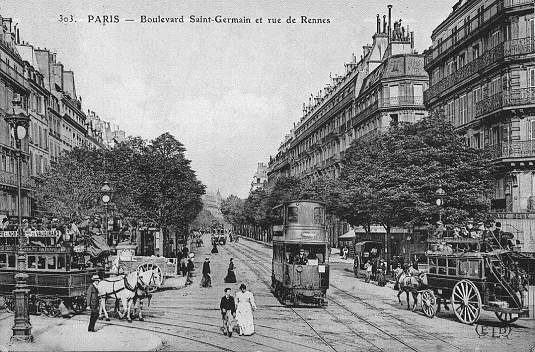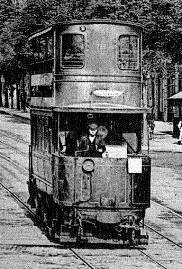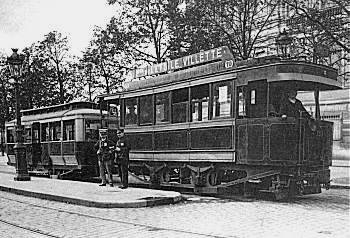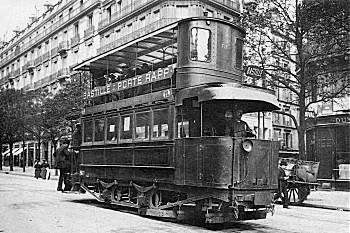

This postcard is number 303 in the ELD series of Parisian publisher Eugène Le Deley. Our example was posted from Paris to Eltham in England on 25th July 1911, and the view dates from around 1910. It shows the Boulevard Saint-Germain at Rue de Rennes with a horse bus, a horse tram on route TAH from Gare du Nord to Boulevard de Vaugirard and a Purrey steam tram on route TL from Bastille to Porte Rapp. All three vehicles were operated by the Compagnie Générale des Omnibus (C.G.O.).
 The central vehicle, Purrey steam tram 723, is the most interesting and is shown in this enlarged extract left. These steam trams were designed by Valentin Purrey, a mechanical engineer and constructor of Rue Saint-Lazarre, Paris (by 1907 Boulevard J.J. Bose, Bordeaux). First prototype examples were tested by the C.G.O. in 1897 on the route from Auteuil to Boulogne and then Louvre to Boulogne and from 1899 Louvre to Sèvres, being compared with Léon Serpollet's steam cars then in use. From 1900 onwards Purrey cars were progressively introduced on routes TL Bastille - Porte Rapp, TP Trocadéro - La Villette, TD Etoile - La Villette, TK Louve - Charenton and TM Gare de Lyon - Avenue Henri-Martin and temporarily on TC Vincennes - Louvre. In total 50 double-deck cars, numbered 701 to 750, were built from 1900 and 36 single-deck cars, numbered 751 to 786, added from 1904. The small view below right is taken from ND Phot postcard no. 4024 and shows single deck Purrey car 758 in about 1910, although the card caption has incorrectly described it as an electric tram.
The central vehicle, Purrey steam tram 723, is the most interesting and is shown in this enlarged extract left. These steam trams were designed by Valentin Purrey, a mechanical engineer and constructor of Rue Saint-Lazarre, Paris (by 1907 Boulevard J.J. Bose, Bordeaux). First prototype examples were tested by the C.G.O. in 1897 on the route from Auteuil to Boulogne and then Louvre to Boulogne and from 1899 Louvre to Sèvres, being compared with Léon Serpollet's steam cars then in use. From 1900 onwards Purrey cars were progressively introduced on routes TL Bastille - Porte Rapp, TP Trocadéro - La Villette, TD Etoile - La Villette, TK Louve - Charenton and TM Gare de Lyon - Avenue Henri-Martin and temporarily on TC Vincennes - Louvre. In total 50 double-deck cars, numbered 701 to 750, were built from 1900 and 36 single-deck cars, numbered 751 to 786, added from 1904. The small view below right is taken from ND Phot postcard no. 4024 and shows single deck Purrey car 758 in about 1910, although the card caption has incorrectly described it as an electric tram.
 The unique feature of the Purrey cars was their steam generators, fully described in connection with the trams in Rockhampton, Australia (see Postcard). These generators were highly successful and were later fitted to former compressed air cars and to some Serpollet cars.
The unique feature of the Purrey cars was their steam generators, fully described in connection with the trams in Rockhampton, Australia (see Postcard). These generators were highly successful and were later fitted to former compressed air cars and to some Serpollet cars.
The trams had a two cylinder simple engine with a central common steam chest and slide operated valves, all being enclosed in a casing to keep out road dirt. It was held into the truck by means of just four bolts, which aided easy removal for maintenance. The cut-off was adjustable but was pre-set, which although making the driving more simple meant that the tram was less efficient on steam (and thus coke) than the contemporary Serpollet cars. Reversing was by means of adjustable eccentrics driving the valve gear. The oil enclosed crankshaft was connected to the tram axles by means of Reynolds chain drive with a 3:1 gear ratio. The cylinders were 175mm bore and 162mm stroke. Steam exhausted via the chimney, where there was a silencer and on some later cars a condenser, but could be diverted to the firebox via a steam ejector to form a forced draft when climbing hills, and had one pipe available to heat the interior of the tram. The wheel diameter was 750mm and the tram developed around 16 horsepower. The trams usually ran at 14 k.p.h. with a maximum of 16 k.p.h. and used approximately 12 litres of water and 2.5 kg of coke per hour, giving the vehicle a range of 20 to 25 kilometres.
The main dimensions were similar for both types of car body. They were 8.68 metres long, 2 metres wide and weighed around ten tons empty and just under 13 tons laden. The double-deck cars were 4.725 metres high and carried 48 people, 20 inside, 24 on top and 4 on the platform. The single-deck cars were 3.63 metres high and carried 32 people, 16 inside and 16 on the platform. Both types of car were single-ended and could pull trailers. They were fitted with two couplings, a rigid one at the front for emergency towing and a sprung one at the rear for the trailers. The bumpers were elastic and consisted of a cross arm resting on a bladed spring.
 This small side view left of car 717 is extracted from an ND Phot postcard (no. 4004) taken in 1910 close to the location of the main view. These double-deck cars had two boarding steps, one to the inside and one to the staircase to the upper deck. There was also a door from the driver's compartment into the saloon for use in emergencies. The trucks were formed from two beams with "U" sections at the ends. The wheelbase was nominally 1900 mm but the position of the oil-filled axleboxes in the hornways was adjustable to provide for drive chain tensioning. The cars were fitted with hand brakes and Soulerin air brakes, with a second set of controls at the rear end of the car for emergencies, and a compressor driven from the same eccentric on the front axle that was used by the car's water pump. It was claimed that a two car "train" could be stopped from 20 k.p.h. on a 20mm slope in a distance of 20 metres. The trams were illuminated by oil lamps.
This small side view left of car 717 is extracted from an ND Phot postcard (no. 4004) taken in 1910 close to the location of the main view. These double-deck cars had two boarding steps, one to the inside and one to the staircase to the upper deck. There was also a door from the driver's compartment into the saloon for use in emergencies. The trucks were formed from two beams with "U" sections at the ends. The wheelbase was nominally 1900 mm but the position of the oil-filled axleboxes in the hornways was adjustable to provide for drive chain tensioning. The cars were fitted with hand brakes and Soulerin air brakes, with a second set of controls at the rear end of the car for emergencies, and a compressor driven from the same eccentric on the front axle that was used by the car's water pump. It was claimed that a two car "train" could be stopped from 20 k.p.h. on a 20mm slope in a distance of 20 metres. The trams were illuminated by oil lamps.
The last Purrey steam trams ran in Paris on 13th June 1914 on the routes Etoile - La Villette and Trocadéro - La Villette.
![]() Go to Postcard Of The Month Index
Go to Postcard Of The Month Index